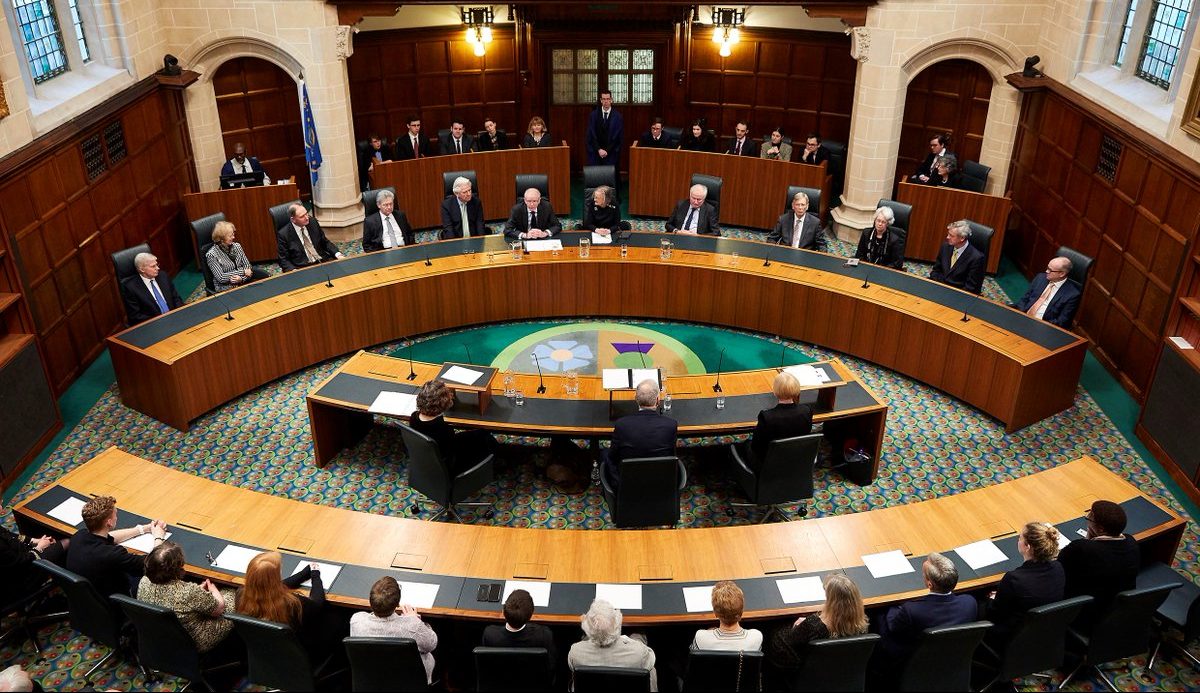Debating can seem intimidating from watching on the sidelines, with speakers appearing confident, passionate, and flawless. However, debating consists of skills that anybody can learn. Debating may not be something that you encounter every day during your work but these skills can be incredibly valuable and are definitely transferable.
What is debating?
A debate is a structured contest about an issue or resolution. A formal debate involves two sides: one supporting and one opposing. Debates may be judged in order to declare a winning side.
The benefits to debating include:
- Encourages you to speak strategically and succinctly.
- Improving your public speaking skills.
- Learning how to create a persuasive argument, especially useful for academic and professional success.
- When you have to argue against your personal view, you realise that there are two sides to the argument.
Debate Structure
There are multiple formats a debate can follow. The basic debate structure is as follows:
Topic
- A topic is chosen for each debate, known as the resolution or motion. It can be a statement, policy, or idea.
- The motion is usually a policy that changes the current state of affairs or a statement that is either true or false. The motion typically starts with “This House…”
The setup
- A debate normally consists of two teams of three speakers:
- The Affirmative team support the statement
- The Negative team oppose the statement
- You will normally be allocated your position in the debate.
- Teams are provided with time to prepare
- Each speaker presents their ideas and rebuttals for a set amount of time (around 5 – 10 minutes)
- Speakers alternate between the teams, usually a speaker in the Affirmative team starts, followed by an Opposition speaker, then the second Affirmative speaker presents, followed by the second Negative speaker, etc.
- There is a moderator (usually the host) who introduces each speaker and keeps time.
- The debate is then judged, usually by a panel of three/five or by the audience in attendance. There may be an audience present but they are not involved in the debate.
Barack Obama and Mitt Romney during a Presidential Debate in 2012. Debating is an important skill in many aspects of life, from winning political seats to negotiating new contracts as a lawyer.
Roles of the Speakers
Each speaker typically does the following in a debate:
First Affirmative Speaker
The first speaker on the affirmative team presents arguments in support of the resolution. (5 – 10 minutes)
- Contextualise (introduce) the debate – clearly set out the team’s interpretation of the topic and the significant issues they disagree with.
- Provides definitions if necessary for understanding during the argument.
- Outline the team line and the team split – this is where you outline your team’s case and summarise the way your arguments have been divided between your speakers.
- Provide 2-3 arguments supporting the motion.
First Negative Speaker
The first speaker on the opposing team presents arguments opposing the resolution.
- Re-contextualise the debate and resolve any definitional issues – if you have disagreements with the definition given by the Affirmative these must be handled immediately. If you want to challenge the definition then you must prove that you have the most appropriate definition. There are three main steps in a definitional challenge:
-
- Clearly state your definition
- Provide your arguments as to why this is the superior definition
- Rebut the Affirmative’s arguments supporting their definition
- Outline a team line and team split.
- Rebut the arguments made by the First Affirmative Speaker.
- Deliver 2-3 arguments against the motion.
Second Affirmative Speaker
The second affirmative speaker presents further arguments in support of the resolution, identifies areas of conflicts, and answers questions that may have been raised by the opposition speaker. (5 – 10 minutes)
- If needed, resolves any definitional issues.
- Rebut the arguments made by the First Negative’s arguments.
- Deliver 2-3 arguments against the motion.
Second Negative Speaker
The second speaker on the opposing team presents further arguments against the
resolution, identifies further areas of conflict, and answers questions that may have been raised by the previous affirmative speaker. (5 – 10 minutes)
- If needed, resolve any definitional issues.
- Rebut the arguments made by the Affirmative team up to this point, with a focus on the Second Affirmative’s arguments.
- Deliver 2-3 arguments against the motion.
Third Affirmative Speaker/Third Negative Speaker
- Rebut specific issues raised by Second Negative and defend any other important attacks on your team’s case.
- Conclude your speech with a brief summary (1-2 minutes) of your team’s case. You should include the key issues which you and the Negative team disagreed on during this.
- You can introduce new material but this is interpreted as poor team planning.
The Judges/Audience
- If there is an audience, the debate may open up to questions from the floor.
- The judges will be assessing their performance during their speeches and how they interact with questions from the audience.
- After all speeches and questions have been delivered, the judges will make their decision on which team won the debate.
Points of Information
In university, it is common to have debates that feature “Points of Information”. This is where during a speech, the opposition is allowed to ask a question or make a point.
They stand up and say “point of information” or “on that point”. The speaker can choose to accept or reject the point. If accepted, the point of information can last around 15 seconds and the speaker can ask for it to stop at any time.
The Prime Minister during a Parliamentary Debate.
Debate Definitions
Providing definitions for technical terms during your speech can help the judges and audience to better understand your argument. The best method to determine whether you should define a term is to ask yourself: will my speech be confusing if I do not define this term? Could the opposition misinterpret what I mean without a definition?
For example, the motion could be “This House believes we should ban plastic straws”. It is rather clear what “plastic straws” are but what does “ban” mean?
If the topic is vague then you will have more choice of definitions. You have a duty to pick a clear definition and one that will create a good debate. If not, this may cause a definitional challenge which will ruin the debate and frustrate the judges.
- Look at the context and determine if there has been a recent significant event related to the topic – the media is the best place to look.
- Which definition will lead to the best debate, which will be more interesting and debatable?
If one definition passes both tests then that is the one you should use. When providing your definition, explain the context used to form the definition. This is important because your understanding of the context may be different from others due to various factors, such as religion, culture, gender, etc.
Basic Argument Structure
There are various ways of dividing up cases according to groups of arguments, such as social/economic/political, etc. You could assign each speaker to handle a group.
Place the most important arguments first, for example, “The media has more influence on self-esteem than anybody else. This is true for three reasons. Firstly (most important argument)… Secondly…, Thirdly (least important argument)…”
To structure an argument, follow these steps:
- Claim – present your argument in a clear statement. This claim is one reason why you’re in favour of/against the motion.
- Evidence – the evidence supporting your claim, such as, statistics, references, quotes, analogies etc.
- Impact – explain the significance of the evidence – how does this support your claim?
Rebuttal
Arguments are weakest at the evidence stage as it is easy to argue against, for example, the evidence may consist of isolated examples or there may be counter-evidence. But it’s not a good technique because the opposition can provide more evidence or rebut your criticisms.
It is difficult to rebut claims because they are usually reasonable but if you can attack a claim then that speaker’s whole argument falls apart. So if you think a claim is vulnerable then rebut it but you will need a strong explanation to show why it doesn’t matter.
There are common flaws you can look for to form a rebuttal:
1. False dichotomy – this is where the speaker is trying to falsely divide the debate into two sides even though there are more alternatives than they state. It is likely the speaker is doing this on purpose but in some cases, they do not understand the debate.
2. Assertion – this is when a speaker presents a statement that is not actually an argument because there is no reason to believe that the statement is valid. It may just be an assumption. You can point out that there has not been enough examination to prove this validity and then give a reason why the assertion is (probably) not valid.
3. Morally flawed – arguments can be morally flawed, for example, “All criminals given a prison sentence should be given the death penalty instead, this will save the country money and space.” What has been argued is true but it’s clearly morally flawed.
4. Correlation rather than causation – a speaker may suggest a link between two events and suggest one led to the other. But the speaker may not explain how one caused the other event which can make an argument invalid.
5. Failure to deliver promises – sometimes a speaker might fail to complete a task they promised to deliver. For instance, they may state that they will provide evidence supporting a certain claim but they may lose track of what they have said and not actually do this.
6. Straw man – the opposing team introduces an argument and then rebuts it. They may use an extreme example of your proposal or perhaps they were hoping that you would make this argument.
7. Contradiction – an argument the other team presents may contradict one of their previous arguments. You must point out that the arguments cannot be true simultaneously and then explain how this reduces their case’s credibility.
8. Compare the conclusion to reality – think “what would happen if what they (the other team) are suggesting is implemented right now?” This usually shows that it’s more complicated than they have suggested and the changes can cause secondary problems.
Scoring
Judges generally score the speakers looking at this criteria:
1. Content / Matter – What the debaters say, their arguments and evidence, the relevance of their arguments.
2. Style / Manner – How the debaters speak, including the language and tone used.
3. Strategy / Method – The structure of the speech, the clarity, and responding to other’s arguments.
The UK Supreme Court in session. Debating is an important skill for lawyers to possess, in particular criminal and litigation lawyers.
Important Skills for Debating
To meet the judge’s criteria, you will have to develop certain skills such as the following:
- You points must be relevant to the topic.
- Provide evidence whenever you can and not your personal opinion.
- You must put aside your personal views and remain objective when you debate so your argument remains logical. You can be passionate about a topic but interest can turn into aggression and passion can turn into upset.
- Consider the audience’s attention span – make it interesting, for example, don’t just present lots of complicated statistics.
- Use rhetoric to persuade – consider using the three pillars of rhetoric:
- Ethos – the ethical appeal
- Pathos – the emotional appeal
- Logos – the logical appeal
- Use notes but keep them brief and well organised. Use a different piece of paper for rebuttals.
- Similar to looking at conclusions to create rebuttals, think comparatively by asking yourself “How does my plan compare to what’s happening now/what would happen in the world if the other team won?” You can win the debate if you can make comparative claims about why your arguments matter more than the other team.
- Only tell jokes if you’re naturally good at it otherwise this can backfire.
- Flexibility is important because you might get allocated the side of the argument you don’t agree with. You’ll have to work hard to overcome your views. Also use this insight to think of the potential arguments you might make and then plan for counter arguments.
Voice
- Speak clearly and concisely.
- You must talk fast enough to have the time to deliver your speech but slow enough so you can be understood.
- Project your voice to the back of the room.
- Incorporate dramatic pauses.
- Emphasise important words and vary your tone appropriately.
Confidence
- Have a relaxed pose and posture.
- Avoid filler words.
- Know your material.
- Emphasise using gestures and avoid nervous gestures.
- Maintain eye contact with the audience.
Language
- Keep your language simple to avoid confusion.
- Refer to the opposite side as: “My opponent”.
- When making a rebuttal say: “My opponent said…, however…”
- Don’t exaggerate – avoid the words “never” or “always” etc.
- Avoid saying that a speaker “is wrong”, instead say that “your idea is mistaken”.
What to avoid
- Falsifying, making up, or altering evidence.
- Publicly disagreeing with the judges’ decision.
- Attacking a speaker rather than an idea.
- Acting aggressively or offensively towards debaters, judges, audience, etc.
- Interrupting other debaters can suggest that your argument isn’t very strong.
- Disagreeing with facts or obvious truths.
Information and guidance extracted from Virtualspeech.



